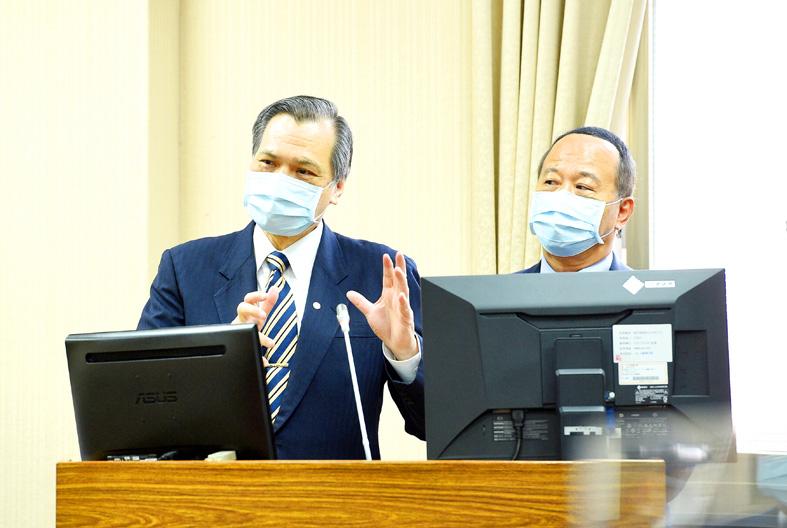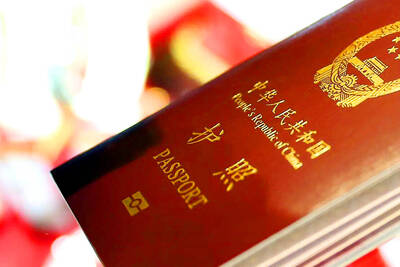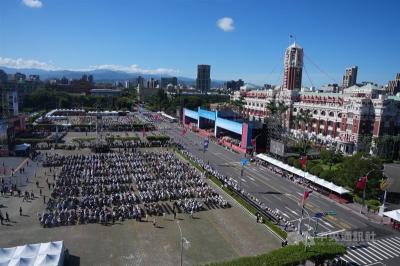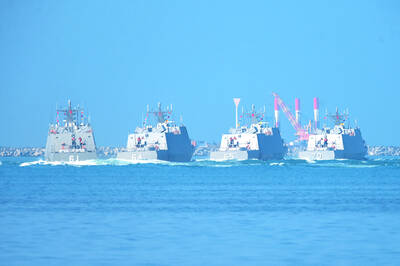It is “highly unlikely” that China would invade Taiwan this autumn, National Security Bureau (NSB) Director-General Chen Ming-tong (陳明通) told lawmakers yesterday, amid reports of a leaked Russian intelligence document suggesting that Chinese President Xi Jinping (習近平) is considering doing so.
“I believe this so-called leaked document is part of cognitive warfare targeting Taiwan,” Chen told a meeting of the legislature’s Foreign Affairs and National Defense Committee, but stopped short of naming China or Russia.
As the Chinese Communist Party (CCP) is scheduled to hold its 20th National Congress this autumn, the party’s main task is to maintain stability, Chen said.

Photo: Peter Lo, Taipei Times
It is therefore extremely unlikely that China would invade Taiwan at that time, he said.
Xi is widely expected to secure a third five-year term as the head of the CCP at the congress, and embark on a reshuffle that could see top party leaders replaced.
The alleged document was made public last week by Russian dissident Vladimir Osechkin.
According to the letter, which Osechkin said was from an intelligence officer in the Russian Federal Security Service, Xi was “considering taking over Taiwan in the fall ... as he needs his own little victory to get re-elected for a third term.”
However, “after the Ukrainian events, this window of opportunity has been closed” to Xi, which now gives the “United States the opportunity to both blackmail Xi and negotiate with its competitors on favorable terms,” the letter said.
The military said it has no comment when asked about the document.
Chen told lawmakers that the Russian invasion of Ukraine was a wake-up call for the democratic world to be more alert to the threats posed by authoritarian countries like Russia and China.
Unlike Europe and the US, which have an existing collective security system, East Asia does not have a similar mechanism and cannot mount a swift response if war breaks out in the Taiwan Strait, Chen said.
However, the US’ Taiwan Relations Act commits Washington to providing Taipei with the means to defend itself, which can serve as a legal basis for the US to assist Taiwan in case of a Chinese invasion, he said.
Chen added that he does not see China adopting a “reunification law,” as it would put too much pressure on Beijing to set a timetable for bringing Taiwan under its control, which could severely raise tensions.
China has not officially proposed such legislation, which would be a follow-up to its passage of the Anti-Secession Law in 2005 giving Beijing the legal basis for military action should Taiwan secede or consider seceding from China.
However, it has been discussed in state media. Asked about a political adviser’s suggestion that such a law be enacted, a spokesperson for China’s Taiwan Affairs Office last week said that it would “carefully listen to, and study opinions and suggestions.”
Adopting a reunification law would be “equivalent to setting a timetable,” Chen said. “In the past, during the Deng Xiaoping (鄧小平) era, they tried to set a timetable, but in the end thought it best not to, as it would put pressure on them.”
Additional reporting by Reuters

The Ministry of the Interior (MOI) is to tighten rules for candidates running for public office, requiring them to declare that they do not hold a Chinese household registration or passport, and that they possess no other foreign citizenship. The requirement was set out in a draft amendment to the Enforcement Rules of the Public Officials Election and Recall Act (公職人員選舉罷免法 ) released by the ministry on Thursday. Under the proposal, candidates would need to make the declaration when submitting their registration forms, which would be published in the official election bulletin. The move follows the removal of several elected officials who were

The Republic of China (ROC) is celebrating its 114th Double Ten National Day today, featuring military parades and a variety of performances and speeches in front of the Presidential Office in Taipei. The Taiwan Taiko Association opened the celebrations with a 100-drummer performance, including young percussionists. As per tradition, an air force Mirage 2000 fighter jet flew over the Presidential Office as a part of the performance. The Honor Guards of the ROC and its marching band also heralded in a military parade. Students from Taichung's Shin Min High School then followed with a colorful performance using floral imagery to represent Taiwan's alternate name

FOUR DESIGNATED AREAS: Notices were issued for live-fire exercises in waters south and northwest of Penghu, northeast of Keelung and west of Kaohsiung, they said The military is planning three major annual exercises across the army, navy and air force this month, with the navy’s “Hai Chiang” (海強, “Sea Strong”) drills running from today through Thursday, the Ministry of National Defense said yesterday. The Hai Chiang exercise, which is to take place in waters surrounding Taiwan, would feature P-3C Orion maritime patrol aircraft and S-70C anti-submarine helicopters, the ministry said, adding that the drills aim to bolster the nation’s offshore defensive capabilities. China has intensified military and psychological pressure against Taiwan, repeatedly sending warplanes and vessels into areas near the nation’s air defense identification zone and across

A Chinese takeover of Taiwan would severely threaten the national security of the US, Japan, the Philippines and other nations, while global economic losses could reach US$10 trillion, National Security Council Deputy Secretary-General Lin Fei-fan (林飛帆) wrote in an article published yesterday in Foreign Affairs. “The future of Taiwan is not merely a regional concern; it is a test of whether the international order can withstand the pressure of authoritarian expansionism,” Lin wrote in the article titled “Taiwan’s Plan for Peace Through Strength — How Investments in Resilience Can Deter Beijing.” Chinese President Xi Jinping’s (習近平) intent to take Taiwan by force